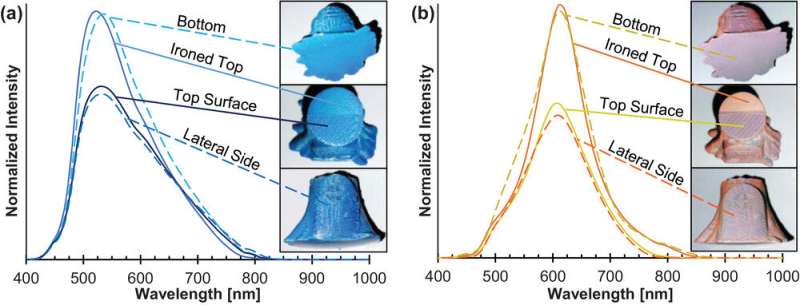This article has been reviewed according to Science X's editorial process and policies. Editors have highlighted the following attributes while ensuring the content's credibility:
fact-checked
peer-reviewed publication
trusted source
proofread
In a world-first, chemists print complex structurally colored 3D objects

If someone has a "hard shell but a soft center," that's often regarded as an appealing character trait. But for Professor of Polymer Chemistry Markus Gallei and his doctoral student Lukas Siegwardt the appeal lies in creating objects called "perfect particles" with a hard center and a soft shell.
The term "perfect particles" is used to refer to particles that are all of identical size and shape. Siegwardt and Gallei have now modified these starting materials, which are typically made of common polymers such as polystyrene or poly(ethyl acrylates), so that they can now be processed in a 3D printer—something that has not so far been possible.
Methods to artificially fabricate materials that show structural colors have been around since 2001, but have been restricted to ultrathin films, fractions of a millimeter thick. "Conventionally, these materials have been processed in industrial presses or film rolling equipment, to produce thin polymer films that can change color," explained Professor Gallei.
The color of the film can be changed by numerous means, such as pulling the material, applying an electric voltage to it, changing the temperature or modifying the pH, to name but a few. "You can essentially control the color of the material on demand," said Markus Gallei. The two great advantages of such structural colors are that they are completely harmless—unlike many conventional dye pigments—and that they never fade.
Additionally, these materials are almost infinitely transformable, something that until recently was limited by the fact that they could only be produced as ultrathin films. If these materials could be shaped into 3D objects, they could be used in a wide range of applications, such as in anti-counterfeiting technology or as versatile measurement sensors, to name just two potential future uses. The particles can be manufactured so that they have highly specific properties, while also being easy to shape.
Lukas Siegwardt demonstrates the chameleon-like nature of the material by pulling on a printed test specimen about five centimeters in length. As he pulls, the object's color changes progressively from red to blue. "So you can see that this material already functions as a simple sensor that can react to tensile and compressive forces," explained Siegwardt.
To understand the underlying chemistry, we need to go back to those "perfect particles" of standard polymers that were mentioned earlier. These are commercially available as a white, tacky powder that is fed into an industrial press or, now more frequently, into a 3D printer.
"During the printing process, the particles arrange themselves into regular patterns and these patterns will have different colors depending on the spacing between the particles," explained Markus Gallei.
The soft shells of the individual particles melt to create a flowable mass that surrounds the hard cores. Pulling on an object changes the distances between the individual core particles and the color changes accordingly. The hard perfect particles move within the soft surrounding medium and arrange themselves into a new pattern. Markus Gallei explained this molecular-level rearrangement as being like "squeezing honey from out between the individual particles."
Changing the distances between these minute particles changes the way the material interacts with visible light, thus changing the colors we observe.
But preparing such materials for 3D printing involved a lot of lab work for Lukas Siegwardt. "I modified the material so that it could actually be printed. It took me months to find the right composition and the right recipes," says Siegwardt. There were two tough nuts to crack in the process. First, Siegwardt had to modify the flow properties of the powdery starting material so that the particles didn't clog the printer's nozzles and the material could be printed with as little residue as possible.
"The second issue was the material's thermal properties. In an industrial press, the starting material has to withstand about 120 °C. But in a 3D printer, the material experiences temperatures of 140 °C and sometimes as high as 200 °C," said Siegwardt, explaining the demands placed on the material. "Many of the materials I tested during those months were simply not up to the job," he recalled. But his perseverance paid off and he finally found the right recipe.
Thanks to their efforts, the two research scientists from Saarland University have established a method that can be used to develop new and practical applications for these shimmering structurally colored objects. And it's all down to a soft shell and a hard core.
The research is published in the journal Advanced Functional Materials.
More information: Lukas Siegwardt et al, Complex 3D‐Printed Mechanochromic Materials with Iridescent Structural Colors Based on Core–Shell Particles, Advanced Functional Materials (2023). DOI: 10.1002/adfm.202213099
Journal information: Advanced Functional Materials
Provided by Saarland University





















